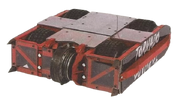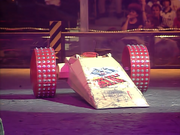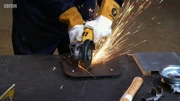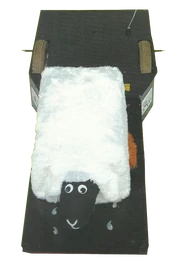Armour (spelt as Armor in US versions) is a vital defensive component for all Robot Wars robot designs. It consists of an outer covering placed over or integrated within the chassis, providing protection to internal components from opponents' weaponry.
Armour can consist of a variety of different shapes, construction methods and materials, ranging from plates to full-sized bodyshells concealing the entire chassis and internals. The methods and materials used to make them continuously evolved and developed throughout the course of the show's televised runs.
Definition[]

Tornado, a robot with polycarbonate armour (transparent) and a steel chassis (red)
Armour refers to the protective outer layer surrounding a robot to stop opponents and arena hazards damaging its vital internals. This differentiates it from a chassis, which is the framework supporting the robot's internal layout and on which armour is attached to.

The laser-cut HARDOX chassis for the Series 10 Apollo, prior to assembly
In most designs, the chassis and armour are usually kept separate, with the armour providing much of the robot's defence against damage. Alternatively, newer designs seen in the rebooted series (e.g. Apollo) often integrated substantial armour plating into the chassis itself, made possible through the use of modern water or laser cutting methods.

Weber, a robot with large non-structural tubing as external armour
Armour does not have to consist of a complete covering, as sometimes meshes or a more skeletal construction can be used to bring the robot's weight down. Another option is to remove certain sections of armour from the robot completely, a matter commonly used by competitors to comply with the weight limit of any given series. This kind of armour must be separate from the chassis for it to be considered deliberate armour, and not just an armourless section.

Wheely Big Cheese's titanium flipper doubled as its main armour
Weapons, wheels and decorations may also function as armour in certain situations. Robots such as Typhoon 2 and Wheely Big Cheese featured full-bodied weapons on the outside, meaning the materials they are made from constitutes as armour. In most designs, wheels are not usually considered to be armour, though exposed ones can be armoured (such as the leather on the sides of later versions of Barber-Ous). However, there are some cases where wheels have been used as armour, especially so among Axlebots. The large HDPE wheels of Gabriel or the thick domes of Stinger are two examples of this.
Some sacrificial decorations such as toys, mascots and cardboard constructions may situationally prevent damage to the robot sporting them. However, they cannot be classed as armour as their addition in most cases was merely for entertainment. The only decorations which can be classed as defensive are entanglement devices and fur.
Materials[]
Choice of material for armour is vital, as each has a vast array of advantages and disadvantages. Choosing a primary material for armour requires the roboteers to weigh all of these factors up and make a choice for which suits their robot best.
Some example factors to be taken into account when choosing a material are shown in this non-exhaustive list:
- Cost
- Ease of working
- Weight
- Strength
- Durability
- Availability
- Relevant expertise of the roboteers
- Aesthetics
- Defensive concept of the robot
During Heat D of Series 9, Judge Lucy Rogers and co-presenter Angela Scanlon discussed the different materials used as armour in the reboot, along with the logic and reasoning behind each choice.

HDPE showing no damage from the hammer, but a significant cut from an angle grinder
- Lucy Rogers: "[HDPE is] very good at absorbing energy."
- Angela Scanlon: "It's bouncy. Against an axe it works really well."
- Lucy Rogers: "Against a spinner, it's a plastic [so] it's going to melt."
- — Discussion about HDPE after hitting it with a hammer and cutting with an angle grinder
- "It's useless in the arena, but good for prototypes."
- — Lucy Rogers discussing wooden armour
- "Aluminium. For a metal it's soft, it's cheap and light. But you'll probably use it inside for holding some of the structures."
- — Lucy Rogers

HARDOX creates sparks but takes little damage from an angle grinder
- "If you can't afford the HARDOX, go for Mild Steel."
- — Lucy Rogers, discussing stronger metals than Aluminium
- "So that's what we've been seeing with the firework display, but not much damage."
- — Angela Scanlon inspects the scratch left on HARDOX after being ground by the cutter and just sparking
- "Best thing against a spinner - HARDOX. Best against a hammer - HDPE."
- — Lucy's verdict on the protective properties of HARDOX and HDPE materials
Extra additions[]

Lambsy's non-armour toy sheep
As Robot Wars was a television show, teams often added decorative items to their robots to enhance their entertainment value onscreen. Toys, mascots and sacrificial components were among the items to be placed on the exterior armour/chassis on various designs, an example being the toy sheep placed on Lambsy's flipper.
Additional decorations were especially encouraged in the US series Robot Wars: Extreme Warriors as a means to entertain the audience, one example of a competitor being so treated being Tricerabot. Damage to these additions was never taken into account in Judges' decisions; rather, they were deemed sacrificial and offered little to no protection of their own.

Major Tom's plastic head may have stopped Matilda and Shunt penetrating the body, but it was clearly a decoration and thus not classed as armour
Two types of indirect additions can be classed as giving some form of protection:
- Entanglement devices were a form of defence utilising sacrificial components which were designed primarily to snag and entangle spinning weapons, or any other moving devices on opponents. Robots featuring these would score points if the devices were effective, but lose points if they were removed without entangling an opponent.
- Fur was a fan-favourite decorative addition which offered little defence and was often just used for show. A popular use for this material was to set it on fire - either via the flame hazards or by dousing it in a flammable substance - to provide additional entertainment. However, it could also serve as an entanglement device on very rare occasions.
[]
| |||||||||||
